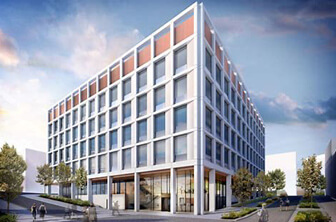Newcastle’s life sciences sector is shining bright, with Helix at the very centre of its growth.
The bright lights of Newcastle hit me as my train pulled into the city, but it wasn’t the touristic sites that stood out. Newcastle’s life sciences and connected academic institutions shone bright, their buildings and names illuminated for all to see. Newcastle has a lot to show-off about. It is home to two of the region’s universities, and Newcastle University, in particular, has strengths in computing sciences and medical sciences as well as social research, with over 600 academic staff involved in different aspects of ageing research. Newcastle is also home to one of the largest NHS hospital trusts in the UK.
Adding to the number of illuminated buildings is the Helix development. A 24-acre vibrant innovation district; built on what was once a Scottish and Newcastle Brewery bottling site. The vision for the district is to “help us all live better lives. Easier, healthier, smarter and longer”. When complete it will provide a mix of research and laboratory space, futuristic homes, restaurants, cafes, office space, open spaces and an amphitheatre. It will be a unique ecosystem that brings together academia, the public sector, communities, innovators, business and industry.
I had the pleasure of visiting the site, including a tour of The Biosphere, a 90,000 sq ft purpose built laboratory and office facility for scaling biology and chemistry-based companies. I spoke to a number of stakeholders including Newcastle University, Invest Newcastle, Newcastle Helix Partnership Manager, occupiers of The Biosphere and The Biosphere Board members. The conversations revealed why Helix is an exemplar UK innovation district and provided concrete evidence of how the five future forces we have identified as transforming the life sciences sector are influencing the shape of innovation districts.
The development brings together industry sectors that are colliding, in particular data sciences, urban sciences and life sciences. Our research identifies how important co-location and collaboration between these areas is becoming. The newly opened Catalyst building is home to Newcastle University’s teams from the National Innovation Centre for Ageing and the National Innovation Centre for Data. It features a range of collaboration space including co-working, a TED style theatre, data visualisation suite and café. The primary focus of the Catalyst building is to develop new products and services via data analytics, as well as helping to address the increasing ageing challenge in the UK.
Helix has strong sustainability and wellbeing credentials. A key feature is the District Energy Centre that seeks to save 30,000 tonnes of carbon over forty years. A five-kilometre network of underground pipes will supply heating and cooling to ten buildings and up to 450 homes planned on site. Sustainability and wellbeing will be increasingly important criteria’s for life sciences occupier’s location decisions, driven by changing employee needs and consumer demands.
Another core future requirement is flexibility. At Helix it is built in. Within The Biosphere, for example, spaces are available on different lease terms, with a variety of floorplates. This is important as our life sciences research clearly shows how SMEs are fuelling a fresh wave of scientific innovation across the UK. These SMEs will need the capability to scale-up or down quickly depending on where they are in their growth journey. We also predict that more traditional life sciences companies will increasingly relocate elements of their R&D to be in close proximity to these innovative SMEs. These occupiers are likely to require larger floorplates, thus making variety in the quantum of space available hugely important.
Finally, Helix will develop with a real and strong sense of community. This not only relates to bringing occupiers and stakeholders together into a curated community via events and considered space design but also to public engagement. Plans for restaurants, cafes, exhibitions and public squares will draw the public in, creating a real sense of place and vibrancy. Some of the buildings will have spaces open to the public for events, exhibitions and even maker spaces to enable the prototyping of ideas. These links with the public will be crucial to life sciences companies as individuals take greater control of their healthcare and life sciences companies look to get young talent excited about a career in science. Taking this idea one stage further, a proportion of the 450 homes could become “living labs” with residents taking part in R&D projects.
With completed buildings such as The Core operating at 90%+ occupancy over its 5 years in operation, and future projections of 4,000 jobs at Helix by 2024 things are set to shine even brighter for life sciences in Newcastle, and Helix will be at the very centre of growth.
Written By: Jennifer Townsend, Knight Frank



